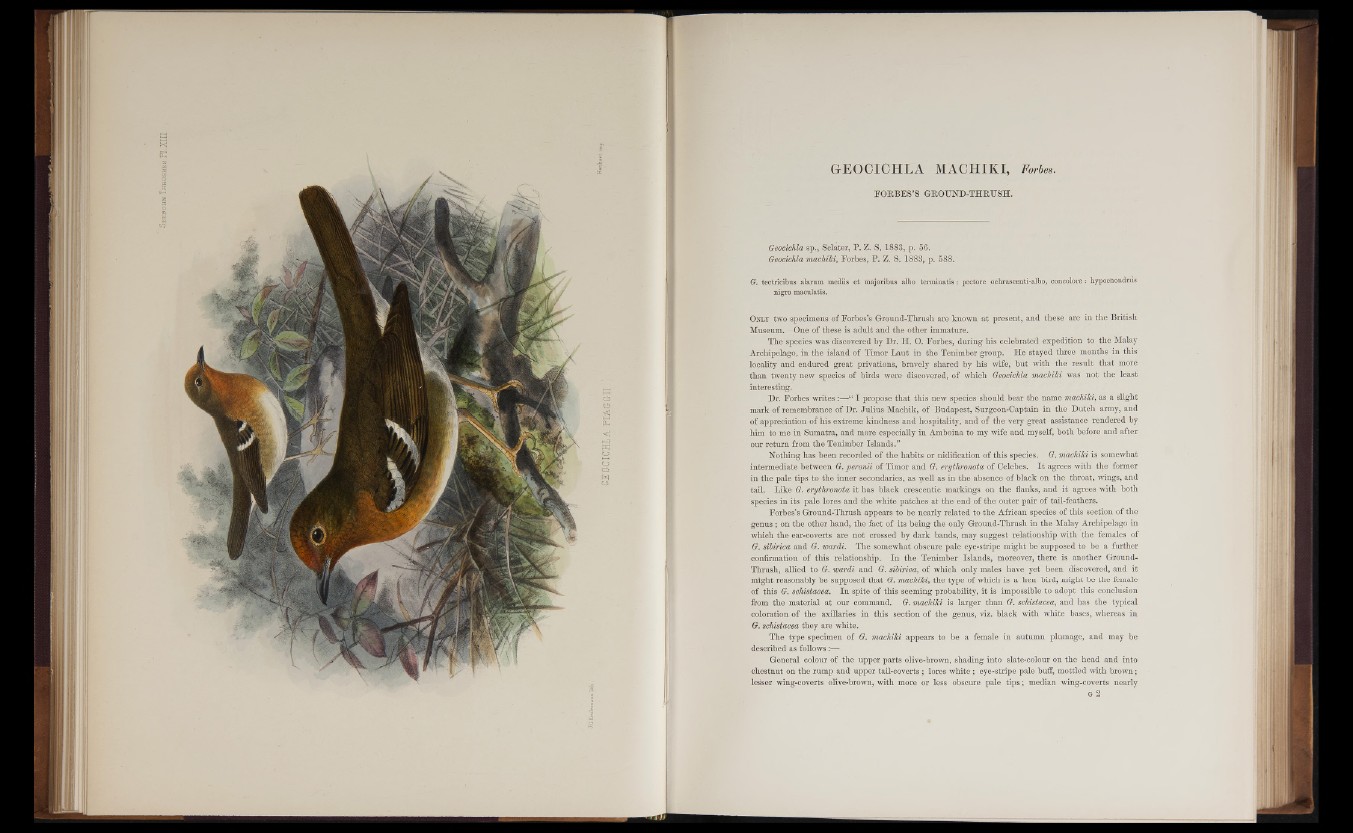
GE'O-CICHLA PIAGG-H. .
FORBES’S GROUND-THRUSH.
Geocichla sp., Sclater, P. Z. S. 1883, p. 56.
Geocichla machiki, Forbes, P. Z. S. 1888, p. 588.
G. tectricibus alarum mediis et majoribus albo termiuatis: pectore ocbrascenti-albo, concolore: bypochondriis
nigro maculatis.
Only two specimens of Forbes’s Ground-Thrush are known at present, and tbese are in the British
Museum. One of these is adult and the other immature.
The species was discovered by Dr. H. O. Forbes, during his celebrated expedition to the Malay
Archipelago, in the island of Timor Laut in the Tenimber group. He stayed three months in this
locality and endured great privations, bravely shared by his wife, but with the result that more
than twenty new species of birds were discovered, of which Geocichla machiki was not the least
interesting.
Dr. Forbes writes :—“ I propose that this new species should bear the name machiki, as a slight
mark of remembrance of Dr. Julius Machik, of Budapest, Surgeon-Captain in the Dutch army, and
of appreciation of his extreme kindness and hospitality, and of the very great assistance rendered by
him to me in Sumatra, and more especially in Amboina to my wife and myself, both before and after
our return from the Tenimber Islands.”
Nothing has been recorded of the habits or nidification of this species. G. machiki is somewhat
intermediate between G. peronii of Timor and G. erythronota of Celebes. It agrees with the former
in the pale tips to the inner secondaries, as ■yell as in the absence of black on the throat, wings, and
tail. Like G. erythronota it has black crescentic markings on the flanks, and it agrees with both
species in its pale lores and the white patches at the end of the outer pair of tail-feathers.
Forbes’s Ground-Thrush appears to be nearly related to the African species of this section of the
genus; on the other hand, the fact of its being the only Ground-Thrush in the Malay Archipelago in
which the ear-coverts are not crossed by dark bands, may suggest relationship with the females of
G. sibirica and G. wardi. The somewhat obscure pale eye-stripe might be supposed to be a further
confirmation of this relationship. In the Tenimber Islands, moreover, there is another Ground-
Thrush, allied to G. wardi and G. sibirica, of which only males have yet been discovered, and it
might reasonably be supposed that G. machiki, the type of which is a hen bird, might be the female
of this G. schistacea. In spite of this seeming probability, it is impossible to adopt this conclusion
from the material at our command. G. machiki is larger than G. schistacea, and has the typical
coloration of the axillaries in this section of the genus, viz. black with white bases, whereas in
G. schistacea they are white.
The type specimen of G. machiki appears to be a female in autumn plumage, and may be
described as follows:—
General colour of the upper parts olive-brown, shading into slate-colour on the head and into
chestnut on the rump and upper tail-coverts ; lores white; eye-stripe pale buff, mottled with brown;
lesser wing-coverts olive-brown, with more or less obscure pale tip s; median wing-coverts nearly